.
13.03.2016
Welcome to French Guiana: two passengers arrive for Arianespace’s next Soyuz flight

Sentinel-1B – encased in its protective shipping container – is unloaded from the chartered Antonov An-124 cargo jetliner following its arrival at Félix Eboué Airport in French Guiana (left photo); while at right, Microscope has been removed from the 747 cargo jetliner and is being readied for transfer by road to the Spaceport.
.
Payload preparation activity for Arianespace’s Soyuz Flight VS14 is underway in French Guiana following the separate deliveries of this upcoming mission’s primary satellite passenger – Sentinel-1B – and the first of three additional payloads that will join it, the Microscope spacecraft.
Sentinel-1B was transported by a chartered An-124 cargo jetliner that landed this week at Félix Eboué International Airport near French Guiana’s capital city, Cayenne – then was unloaded for transfer by road to the Spaceport, where the satellite will be readied for its April 22 launch.
Developed in an industrial consortium led by prime contractor Thales Alenia Space, Sentinel-1B will be orbited for the European Commission’s Copernicus Earth observation program – the goal of which is to ensure European independence in the acquisition and management of environmental data concerning the planet, as well as to support local authorities and policy-makers.
After launch, Sentinel-1B will join its “sister” satellite – Sentinel-1A, which was lofted on a 2014 Arianespace Soyuz mission – in orbit to provide more views of Earth for the Copernicus environmental monitoring effort. Both spacecraft carry an advanced radar for all-weather, day-and-night coverage of Earth’s surface, and working together, will image the entire planet every six days. Arianespace also orbited the Sentinel-2A satellite on a successful Vega mission performed in 2015.
The Microscope passenger for launch on Soyuz Flight VS14 was delivered to French Guiana this week by a 747 cargo jetliner, arriving two days after Sentinel-1B – with a subsequent transfer by road bringing it to the Spaceport for payload processing as well.
Microscope is a 300-kg. satellite built around the CNES French space agency’s Myriade bus, and will be released to a sun-synchronous circular orbit on the April 22 launch – from which it will test the universality of free fall in space, with an accuracy 100-times greater than tests performed on Earth.
CNES’ Microscope is one of three additional payloads to be lofted on Flight VS14, and will be joined by Norway’s first scientific satellite, NORSAT-1; and a cubesat that is part of the European Space Agency’s Fly Your Satellite! educational program.
This upcoming medium-lift Soyuz mission will be the third as part of Arianespace’s busy launch manifest for 2016. It follows two separate flights this year that used heavy-lift Ariane 5 vehicles to orbit Intelsat 29e on January 27; and EUTELSAT 65 West A on March 9.
Quelle: arianespace
-
Update: 19.03.2016
.
Payload preparations advance for Arianespace’s Soyuz mission with Sentinel-1B
The next spacecraft to be orbited for Europe’s Copernicus Earth observation program – Sentinel-1B – is now undergoing pre-launch checkout at the Spaceport, readying it for the April 22 liftoff on Arianespace’s upcoming Soyuz flight from French Guiana.
.

Preparation activity is underway with Soyuz Flight VS14’s Sentinel-1B passenger at the Spaceport’s S5 facility in French Guiana.
-
Sentinel-1B is being put through its paces inside the Spaceport’s S5 payload preparation facility, where the radar satellite was transported following this month’s arrival in French Guiana aboard an An-124 cargo jetliner. During initial preparations, the spacecraft was removed from its shipping container in clean room conditions, then positioned for the start-up of processing.
Developed in an industrial consortium led by prime contractor Thales Alenia Space, Sentinel-1B is to deliver essential data for Copernicus – which is a European Space Agency (ESA) program in partnership with the European Commission. Copernicus’ goal is to ensure European independence in the acquisition and management of environmental data concerning the planet, as well as to support local authorities and policy-makers.
After launch, Sentinel-1B will join its Sentinel-1A “sister” satellite in Sun-synchronous, near-polar, circular orbit. Both spacecraft carry an advanced radar for all-weather, day-and-night coverage of Earth’s surface, and working together, will image the entire planet every six days. Sentinel-1A was launched on a 2014 Arianespace Soyuz mission.
The April 22 flight is designated VS14 in Arianespace’s numbering system, and will be the company’s third mission performed from Europe’s Spaceport in 2016 to date – following successful Ariane 5 launches on January 27 (carrying Intelsat 29e) and March 9 (with EUTELSAT 65 West A).
Three additional passengers are to be lofted along with Sentinel-1B on Soyuz Flight VS14: the CNES French space agency’s Microscope spacecraft; the first scientific satellite for Norway, NORSAT-1; and a cubesat payload that will be orbited as part of ESA’s Fly Your Satellite! educational program.
Quelle: arianespace
.
Update: 24.03.2016
.
A cornerstone of modern physics is to be studied by the Microscope payload on Arianespace’s next Soyuz mission
Pre-launch preparation activity is underway in French Guiana with the Microscope satellite, which will be orbited from the Spaceport in April aboard an Arianespace Soyuz launcher to validate a cornerstone of modern physics: the equivalence principle.
.

The Microscope satellite is readied for its pre-launch checkout in the Spaceport’s S5 payload preparation facility.
.
While in Earth orbit, Microscope will provide data on the relative motion of two bodies in permanent free-fall, studying their movement during several months instead of just seconds possible with ground-based testing.
By furthering knowledge of the equivalence principle – which postulates the equality between gravitational mass and inertial mass – the results from Microscope could open new vistas for theories of gravitation.
Microscope is the French acronym for: Microsatellite à traînée compensée pour l’observation du principe d’equivalence (Microsatellite with drag compensation for observation of the equivalence principle). This 300-kg. payload is based on the French CNES space agency’s Myriade series of microsatellites, and is equipped with cold-gas microthrusters capable of compensating for the smallest trajectory perturbations which might otherwise distort the results.
CNES is in charge of developing the full Microscope system and building the satellite. It is providing 90 percent of funding for this mission, serving as prime contractor in charge of the satellite bus development, satellite integration and testing prior to launch. The space agency also is responsible for construction and operation of the mission control center.
Arianespace Keeps Pace With Its Goal Of 12 Launches In 2016
During Arianespace’s April 22 launch of Soyuz, Microscope will be orbited along with the Sentinel-1B observation radar platform for Europe’s Copernicus Earth observation program, as well as two very small cubesat passengers: Norway’s first scientific satellite, NORSAT-1; and a payload from ESA’s “Fly Your Satellite!” educational program.
The upcoming Soyuz mission is designated Flight VS14 in Arianespace’s launcher family numbering system, and will be the company’s third performed from Europe’s Spaceport to date in 2016 – following successful Ariane 5 launches on January 27 (carrying Intelsat 29e) and March 9 (with EUTELSAT 65 West A).
Arianespace is targeting as many as 12 flights in 2016 with its complete launcher family, composed of the heavy-lift Ariane 5, medium-lift Soyuz and lightweight Vega.
Quelle: arianespace
-
Update: 12.04.2016
.
A trio of miniaturized satellites are ready for Arianespace’s next Soyuz mission

Three “Ps in a pod!” The three CubeSat payloads from ESA’s Fly Your Satellite! program are integrated with Soyuz launcher hardware. At left, the CubeSats are shown arranged side-by-side in their P-POD deployment system. The P-POD is then secured to a vertical mounting bracket that has been attached to the Soyuz launcher’s ASAP-S platform (photos center, and right).
Payload integration has begun for Arianespace’s Soyuz mission on April 22, with the flight’s three miniaturized auxiliary satellite passengers now installed on a special platform that enables multiple payloads to be deployed by the workhorse launcher.
This spacecraft trio is from the Fly Your Satellite! program, an educational outreach of the European Space Agency (ESA) in collaboration with European universities. With the Fly Your Satellite! activity, students are provided practical experience with a space hardware project as part of the newly-established ESA Academy.
For Arianespace’s Soyuz mission to low Earth orbit next week, the three Fly Your Satellite! spacecraft are of the CubeSat-category – sized at 10.5 X 10.5 cm. each, and weighing 1 kg. per payload. They are installed in a deployment system called P-POD, and will be released during a launcher mission lasting a total of four hours.
The three CubeSats are: OUFTI-1 from the University of Liege, Belgium, which will test a new communications subsystem; e-st@r-II, developed by the Politecnico di Torino, Italy to demonstrate an attitude control system using measurements of the Earth’s magnetic field; and AAUSAT4 from the University of Aalborg, Denmark, to operate an automated ocean vessel identification system.
Soyuz’ ASAP-S Platform For Auxiliary Payloads
The P-POD deployment system containing these spacecraft is installed on Soyuz’ ASAP-S platform, which can accommodate several auxiliary payloads. Also integrated with ASAP-S will be the 303-kg. satellite called Microscope – a French CNES space agency spacecraft designed to validate a cornerstone of modern physics: the equivalence principle described by Albert Einstein.
The primary payload for Arianespace’s Soyuz mission on April 22 is Europe’s 2,164-kg. Sentinel-1B satellite, equipped with a C-SAR (C-band synthetic aperture radar) instrument for all-weather, day/night images as part of the Copernicus Earth observation program. Copernicus is managed by the European Space Agency (ESA) in partnership with the European Commission.
The upcoming Soyuz mission is designated Flight VS14 in Arianespace’s launcher numbering system, and will be the company’s third of up to 12 launches planned for 2016 using its family of the medium-lift Soyuz, heavy-lift Ariane 5 and lightweight Vega vehicles. Flight VS14 follows two flights with Ariane 5 performed to date this year: one orbiting the EUTELSAT 65 West A relay satellite in March; and the other lofting Intelsat 29e in January.
---
Fueling is completed for the upper stage on Arianespace’s next Soyuz mission

After emerging from the Spaceport’s FCube fueling operations hall (at left), the Fregat upper stage for Arianespace’s Soyuz Flight VS14 is transferred by road (photo, right) to the S3B clean room, where it will be integrated with the mission’s satellite passengers.
The Fregat upper stage for Arianespace’s upcoming Soyuz launch has completed its fueling at the Spaceport in French Guiana and is ready to be integrated with the mission’s multi-satellite European payload.
Processing of the upper stage for Flight VS14 was performed in the Spaceport’s Fregat Fueling Facility (FCube) – which entered service last year as the latest site at French Guiana created to support Arianespace’s sustained operational cadence.
FCube reduces the time required to “top off” Fregat upper stages during Soyuz launch campaigns. It also frees up another facility previously used for Fregat upper stage fueling operations, the Spaceport’s S3 building – making the S3 facility more available for the processing of customer spacecraft to be lofted by the various members of Arianespace’s launch vehicle family.
Fregat Is Ready To Receive The Passengers For Flight VS14
Fregat is produced by NPO Lavochkin, a company which is part of the Soyuz launcher’s Russian industrial team, and serves as an autonomous and flexible upper stage that extends Soyuz’ capability to perform a full range of missions.
After its fueling in the FCube, the Fregat was transferred by road today to the Spaceport’s S3B clean room, where the upper stage will be integrated with Flight VS14’s passengers: Sentinel-1B, which will provide all-weather, day/night images as part of Europe’s Copernicus Earth observation program; France’s Microscope, designed to validate the equivalence principle described by Albert Einstein; and three miniaturized CubeSats for the European Space Agency’s Fly Your Satellite! university student program.
Flight VS14 is set for liftoff from French Guiana on April 22, deploying its multi-satellite payload during a mission lasting four hours. This will be Arianespace’s third launch in 2016, continuing the company’s pace for as many as 12 flights this year using its medium-lift Soyuz, heavy-lift Ariane 5 and lightweight Vega.
Quelle: arianespace
.
Update: 16.04.2016
.
Der zweite Satellit der Mission Sentinel-1 – Sentinel-1B – wird am 22. April um 23.02 Uhr MESZ von Europas Raumflughafen in Kourou in Französisch-Guayana aus starten. Vertreter der Medien sind eingeladen, dieses Ereignis online mitzuverfolgen oder an der Hauptveranstaltung zum Start im ESRIN, dem ESA-Zentrum für Erdbeobachtung in Frascati bei Rom, teilzunehmen.
Die Sentinel-Satelliten liefern eine Fülle an Daten und Bildmaterial, die den Kern des Copernicus-Programms der EU bilden. Dieses globale Überwachungsprogramm stellt essenzielle Informationsdienste für eine breite Anwendungspalette bereit und markiert somit einen Wendepunkt in unserem bisherigen Umweltmanagement, für unser Verständnis der Auswirkungen des Klimawandels und dessen Bekämpfung sowie unseren Schutz im Alltag.
Die Satelliten der Mission Sentinel-1 verfügen über ein hochentwickeltes Radar, das rund um die Uhr in allen Wetterlagen Bilder von der Erdoberfläche liefert.
Der erste der beiden Satelliten, Sentinel-1A, wurde im April 2014 gestartet und seine Daten werden bereits für zahlreiche Dienste genutzt, darunter die Überwachung der Ausdehnung von Meereis in der Arktis, die routinemäßige Kartierung von Meereis, die Überwachung der Meeresumwelt einschließlich der Überwachung von Ölteppichen und des Aufspürens von Schiffen für die maritime Sicherheit, die Überwachung von Landflächen bei Erdbebenrisiken und die Kartierung zum Forst-, Wasser- und Bodenmanagement sowie zur Unterstützung von humanitärer Hilfe und in Krisensituationen.
Mit dem Start des Zwillingssatelliten Sentinel-1B wird das Satellitenduo jeden Punkt auf der Erde alle sechs Tage – an einigen Stellen sogar noch häufiger – abbilden und somit noch umfassendere Daten für operationelle und wissenschaftliche Anwendungen zur Verfügung stellen können.
.

Einlass ist um 20.00 Uhr MESZ. Führungskräfte der ESA werden zusammen mit Vertretern der Europäischen Kommission und Datennutzern die sozio-ökonomischen Auswirkungen der Mission Sentinel-1 und des Copernicus-Programms erörtern.
Anschließend erfolgt eine Live-Übertragung des Starts aus Französisch-Guayana.
Medienvertreter sollten sich bis Dienstag, den 19. April über folgende E-Mail-Adresse anmelden: Valeria.Andreoni@esa.int.
Ein etwaiger kurzfristiger Aufschub des Starttermins wird auf dem ESA-Portal unter www.esa.int/Sentinel-1 und über Twitter unter @ESA_EO angekündigt.
Berichterstattung
ESA TV wird Fernsehsendern eine Live-Satellitenübertragung des Starts zur Verfügung stellen.
Filmmaterial steht im Videoarchiv zur Verfügung. Ergänzend werden die folgenden neuen Videoproduktionen bereitgestellt: „Fly your satellite“ (15. April) und „Latest from Kourou“ (21. April).
Quelle: ESA
-
Update: 21.04.2016
.
SENTINEL-1B IN POSITION FOR LIFTOFF

With just two days to liftoff, the next Sentinel for Europe’s environmental monitoring programme in now poised high in the launch tower at Europe’s Spaceport in Kourou, French Guiana.
A Soyuz rocket will loft Sentinel-1B into orbit on 22 April at 21:02 GMT (23:02 CEST). Other smaller satellite passengers are also taking advantage of the ride into space.
The rocket was rolled out to the pad yesterday, followed by the fairing and its precious cargo, which was hoisted up and attached to the top of Soyuz.
With the Sentinel-1 mission designed as a two-satellite constellation, Sentinel-1B will join its identical twin, Sentinel-1A, which was launched two years ago from Kourou.
Both satellites carry a high-resolution radar that images Earth’s surface through cloud and rain regardless of whether it is day or night.
By orbiting 180° apart, global coverage and data delivery are optimised for the Copernicus services.
The mission provides radar imagery for a multitude of services and applications to improve everyday life and understand our changing planet.
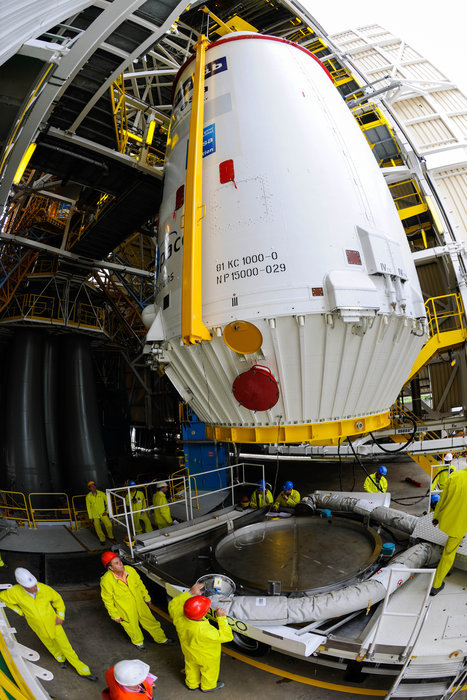




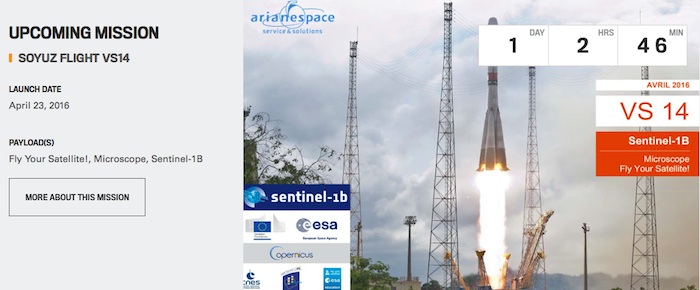
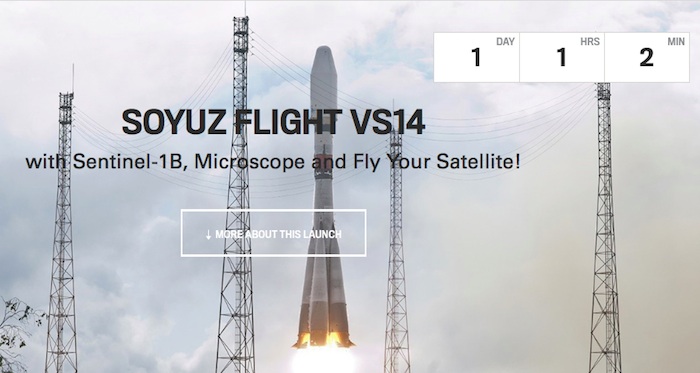



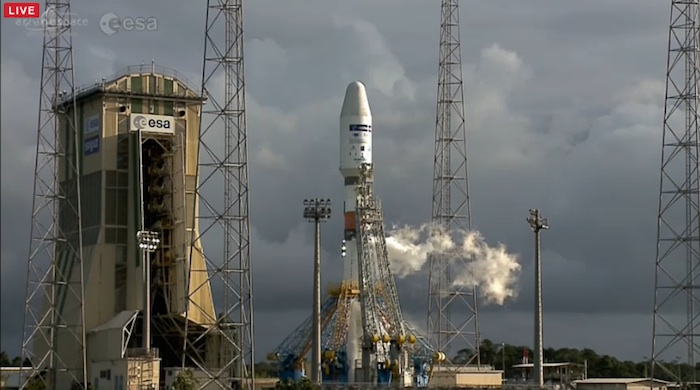
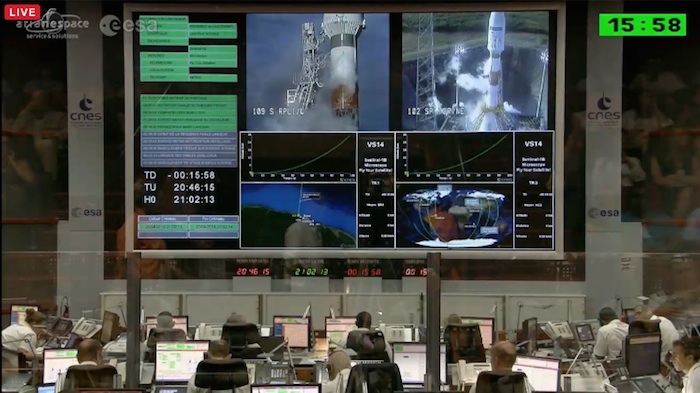

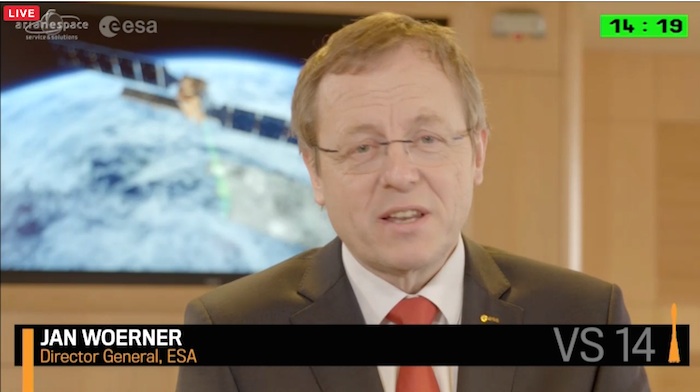
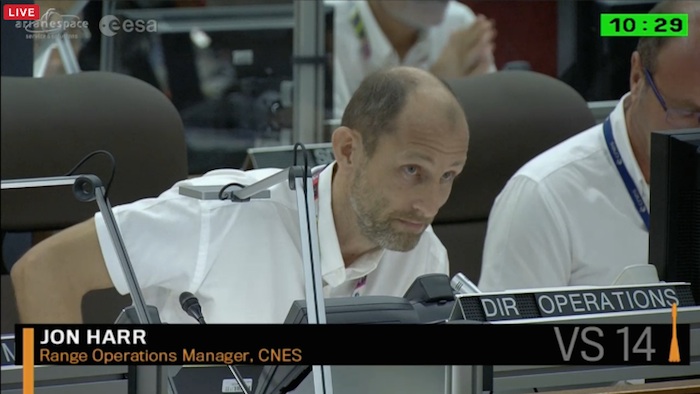

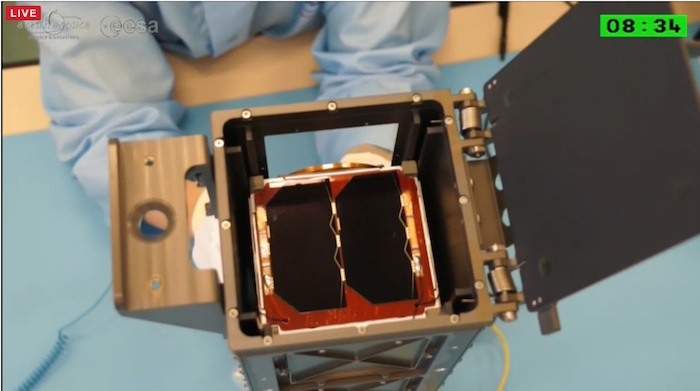

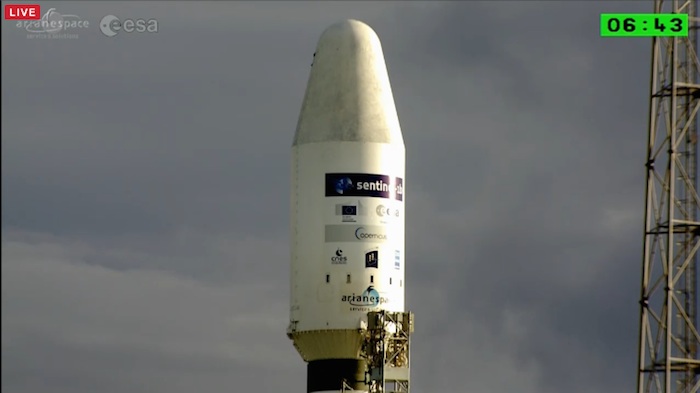



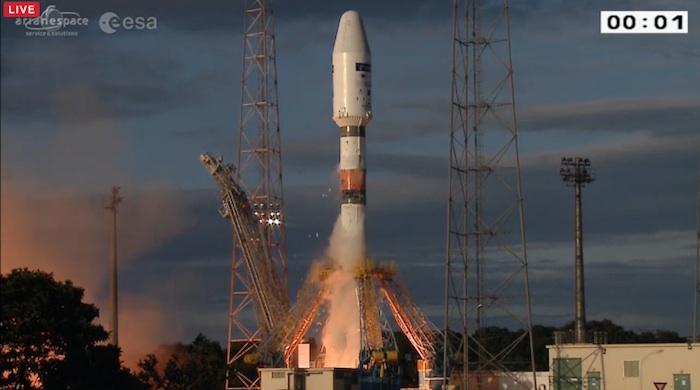

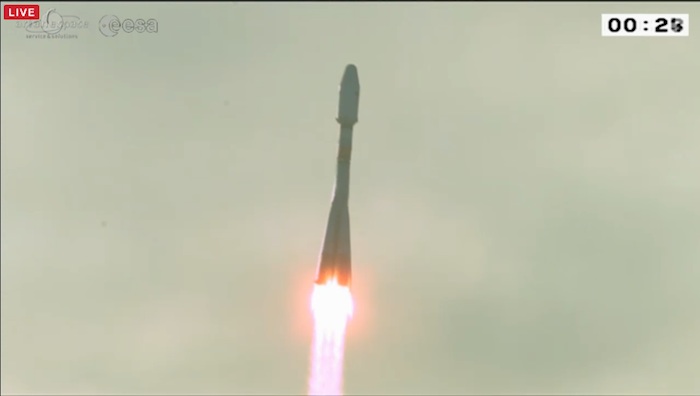



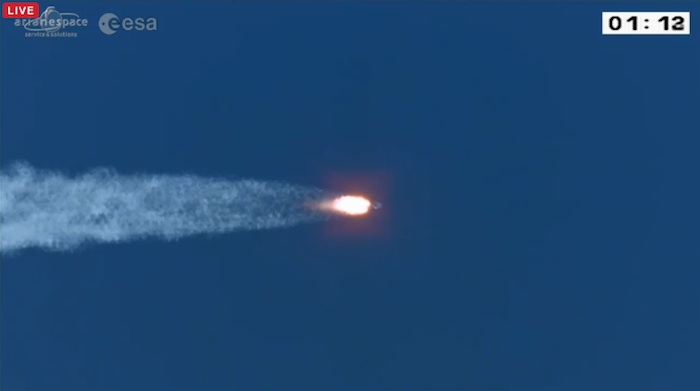

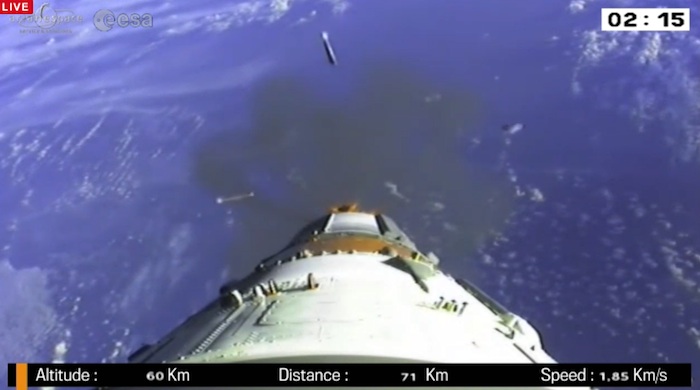
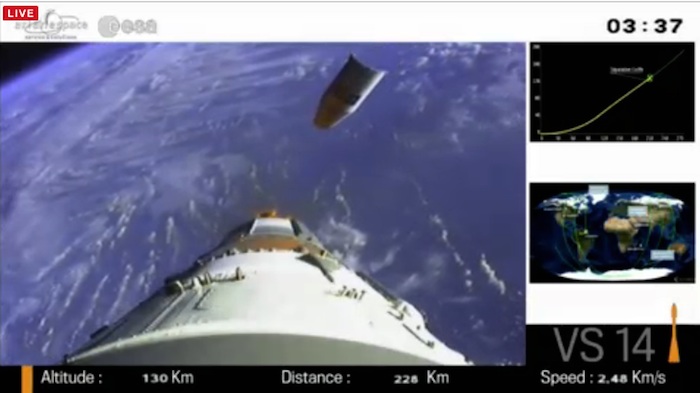




For example, Sentinel-1 is being used to monitor Arctic sea ice, survey the marine environment, monitor the land surface for motion risks, and map forests.
Three CubeSats are piggybacking a ride on Soyuz. These small satellites, each measuring just 10×10×11 cm, have been developed by university student teams through ESA’s Fly Your Satellite! effort.
The other passenger is the Microscope satellite from France’s CNES space agency.
The launch rehearsal is being carried out today by teams at ESA’s mission control centre in Germany and in Kourou – a critical milestone before liftoff on 22 April.
.

QUELLE: ESA
-


Quelle: arianespace
-
Update: 22.04.2016 / 7.00 MESZ
-

-
Update: 22.04.2016 / 18.00 MESZ

Quelle: arianespace
...
Update: 19.55 MESZ

...
ARIANESPACE FLIGHT VS14
SOYUZ - Sentinel-1B – Microscope – Fly Your Satellite!
LAUNCH POSTPONED BY 24 HOURS
The During the technical review prior to the start of Soyuz fueling, the availability of the launcher, satellites, ground facilities and the launch base was confirmed. However, given the weather conditions currently observed above the Guiana Space Center – and the forecast for the moment of liftoff – Arianespace decided to interrupt the final countdown and not initiate launcher fueling operations.
The launch vehicle and its payloads have been placed in stand-by mode, and maintained in fully safe conditions.
As the weather outlook for tomorrow is favorable, Arianespace has set the new Flight VS14 launch date for the evening of Saturday, April 23, 2016, at exactly:
- 06:02:13 p.m., (Local time in French Guiana)
- 05:02:13 p.m., (in Washington, D.C.)
- 09:02:13 p.m., (UTC)
- 11:02:13 p.m., (in Paris)
- 00:02:13 a.m., (in Moscow) on April 24.
Quelle: arianespace
-
Update: 23.04.2016 / 21.45 MESZ
.

ARIANESPACE FLIGHT VS14
SOYUZ - Sentinel-1B – Microscope – Fly Your Satellite!
A NEW LAUNCH DELAY OF 24 HOURS
The latest meteorological observations indicate a “red” weather conditions for the time of liftoff, initially set for Saturday, April 23, 2016, therefore Arianespace has decided not to undertake final fueling operations with the launcher.
The launch vehicle and its payloads have been placed in stand-by mode, and maintained in fully safe conditions.
The new launch date is now set for Sunday, April 24, 2016, at the precise moment of:
- 06:02:13 p.m., (Local time in French Guiana)
- 05:02:13 p.m., (in Washington, D.C.)
- 09:02:13 p.m., (UTC)
- 11:02:13 p.m., (in Paris)
- 00:02:13 a.m., (in Moscow) on April 25.
Quelle: arianespace
-
Update: 24.04.2016
.

...
MICROSCOPE
In 2016, a CNES microsatellite will test the universality of free fall for the first time in space using an experiment 100 times more precise than anything on Earth.
Back in the 17th century, Galileo conceived an experiment, without making it in practice, in which he dropped two objects of different composition and mass together from the top of the Tower of Pisa. In his theory, as the two objects hit the ground at exactly the same time, he deduced that in a vacuum all bodies fall at the same speed. This is what we call the universality of free fall or equality of gravitational and inertial mass, which Albert Einstein later stated as the equivalence principle and made it the basis of his theory of general relativity.
Although it has recently been verified with a degree of precision on the order of 10-13, this principle is nonetheless being pushed to its limits by new theories seeking to reconcile gravitation with fundamental nuclear and electromagnetic interactions, which predict that it could be violated at very weak levels. The Microscope1 satellite will probe these limits further and test the principle with a precision on the order of 10-15. In space, it is possible to study the relative motion of two bodies in almost perfect and permanent free fall on an orbiting satellite, shielded from perturbations encountered on Earth (notably seismic perturbations), over the course of several months.
To achieve this, two concentric cylindrical test masses made of different materials—one titanium and one a platinum-rhodium alloy—will be minutely controlled to maintain them motionless with respect to the satellite inside independent differential electrostatic accelerometers. If the equivalence principle is verified, the two masses will be subjected to the same control acceleration. If different accelerations have to be applied, the principle will be violated: an event that would shake the foundations of physics.
The experiment will be flown on a 300-kg microsatellite—heavier than a usual 100-150 kg microsatellite—built around CNES’s Myriade bus and equipped with cold-gas microthrusters capable of compensating for the tiniest trajectory perturbations that might otherwise skew its results. CNES is providing 90% of funding for this mission, for which it is also prime contractor in charge of satellite bus development, satellite integration and testing up to launch, and construction and operation of the mission control centre.
1 Micro-Satellite à traînée Compensée pour l'Observation du Principe d'Equivalence
Quelle: CNES
-
Update: 22.50 MESZ
.

Quelle: CNES
-
Update: 25.04.2016
.

...22.42 MESZ
.

...22.49 MESZ
LIVE-Launch-VS14
.



...22.55 MESZ





...

















Quelle: arianespace-TV
-
Update: 26.04.2016
-
FLIGHT VS14 – A SUCCESSFUL ARIANESPACE LAUNCH, WITH SO-YUZ, SUPPORTING SUSTAINABLE DEVELOPMENT, FUNDAMENTAL PHYSICS AND PROMOTING SPACE CAREERS
Arianespace successfully launched the Sentinel-1B satellite for the Copernicus program on behalf of the European Commission, under a contract with the European Space Agency (ESA). It also orbited on this mission, the French CNES space agency’s Microscope satellite, and three CubeSats for the ESA Education and Knowledge Management Office’s Fly Your Satellite! program. The Soyuz launcher lifted off on April 25, 2016 at 6:02 pm (local time) from the Guiana Space Center (CSG) in French Guiana.
Arianespace’s third launch of the year was dedicated to European space initiatives for sustainable development, fundamental physics and promoting science and space careers among young Europeans. It clearly confirmed Arianespace’s commitment to its primary mission, namely guaranteeing reliable and independent access to space for Europe.
Quelle: arianespace
4714 Views
